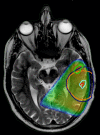Comparison of T2 and FLAIR imaging for target delineation in high grade gliomas
- PMID: 20109218
- PMCID: PMC2827477
- DOI: 10.1186/1748-717X-5-5
Comparison of T2 and FLAIR imaging for target delineation in high grade gliomas
Abstract
Background: FLAIR and T2 weighted MRIs are used based on institutional preference to delineate high grade gliomas and surrounding edema for radiation treatment planning. Although these sequences have inherent physical differences there is limited data on the clinical and dosimetric impact of using either or both sequences.
Methods: 40 patients with high grade gliomas consecutively treated between 2002 and 2008 of which 32 had pretreatment MRIs with T1, T2 and FLAIR available for review were selected for this study. These MRIs were fused with the treatment planning CT. Normal structures, clinical tumor volume (CTV) and planning tumor volume (PTV) were then defined on the T2 and FLAIR sequences. A Venn diagram analysis was performed for each pair of tumor volumes as well as a fractional component analysis to assess the contribution of each sequence to the union volume. For each patient the tumor volumes were compared in terms of total volume in cubic centimeters as well as anatomic location using a discordance index. The overlap of the tumor volumes with critical structures was calculated as a measure of predicted toxicity. For patients with MRI documented failures, the tumor volumes obtained using the different sequences were compared with the recurrent gross tumor volume (rGTV).
Results: The FLAIR CTVs and PTVs were significantly larger than the T2 CTVs and PTVs (p < 0.0001 and p = 0.0001 respectively). Based on the discordance index, the abnormality identified using the different sequences also differed in location. Fractional component analysis showed that the intersection of the tumor volumes as defined on both T2 and FLAIR defined the majority of the union volume contributing 63.6% to the CTV union and 82.1% to the PTV union. T2 alone uniquely identified 12.9% and 5.2% of the CTV and PTV unions respectively while FLAIR alone uniquely identified 25.7% and 12% of the CTV and PTV unions respectively. There was no difference in predicted toxicity to normal structures using T2 or FLAIR. At the time of analysis, 26 failures had occurred of which 19 patients had MRIs documenting the recurrence. The rGTV correlated best with the FLAIR CTV but the percentage overlap was not significantly different from that with T2. There was no statistical difference in the percentage overlap with the rGTV and the PTVs generated using either T2 or FLAIR.
Conclusions: Although both T2 and FLAIR MRI sequences are used to define high grade glial neoplasm and surrounding edema, our results show that the volumes generated using these techniques are different and not interchangeable. These differences have bearing on the use of intensity modulated radiation therapy (IMRT) and highly conformal treatment as well as on future clinical trials where the bias of using one technique over the other may influence the study outcome.
Figures




Similar articles
-
[Changes in target volumes definition by using MRI for prostate bed radiotherapy planning--preliminary results].Klin Onkol. 2010;23(4):256-63. Klin Onkol. 2010. PMID: 20806824 Czech.
-
Target definition for malignant gliomas: no difference in radiation treatment volumes between 1.5T and 3T magnetic resonance imaging.Pract Radiat Oncol. 2014 Sep-Oct;4(5):e195-e201. doi: 10.1016/j.prro.2013.11.003. Epub 2014 Jan 8. Pract Radiat Oncol. 2014. PMID: 25194105
-
FET-PET for malignant glioma treatment planning.Radiother Oncol. 2011 Apr;99(1):44-8. doi: 10.1016/j.radonc.2011.03.001. Epub 2011 Mar 30. Radiother Oncol. 2011. PMID: 21458093
-
Positron emission tomography for radiation treatment planning.Strahlenther Onkol. 2005 Aug;181(8):483-99. doi: 10.1007/s00066-005-1422-7. Strahlenther Onkol. 2005. PMID: 16044216 Review.
-
Target volumes in radiotherapy for high-grade malignant glioma of the brain.Radiother Oncol. 2000 Aug;56(2):151-6. doi: 10.1016/s0167-8140(00)00216-4. Radiother Oncol. 2000. PMID: 10927133 Review.
Cited by
-
Chemoirradiation for glioblastoma multiforme: the national cancer institute experience.PLoS One. 2013 Aug 5;8(8):e70745. doi: 10.1371/journal.pone.0070745. Print 2013. PLoS One. 2013. PMID: 23940635 Free PMC article.
-
MiRNA expression patterns predict survival in glioblastoma.Radiat Oncol. 2011 Nov 10;6:153. doi: 10.1186/1748-717X-6-153. Radiat Oncol. 2011. PMID: 22074483 Free PMC article.
-
Multi-modal tumor segmentation methods based on deep learning: a narrative review.Quant Imaging Med Surg. 2024 Jan 3;14(1):1122-1140. doi: 10.21037/qims-23-818. Epub 2024 Jan 2. Quant Imaging Med Surg. 2024. PMID: 38223046 Free PMC article. Review.
-
MR imaging of neoplastic central nervous system lesions: review and recommendations for current practice.AJNR Am J Neuroradiol. 2012 May;33(5):803-17. doi: 10.3174/ajnr.A2640. Epub 2011 Oct 20. AJNR Am J Neuroradiol. 2012. PMID: 22016411 Free PMC article. Review.
-
Potential applications of imaging and image-guided radiotherapy for brain metastases and glioblastoma to improve patient quality of life.Front Oncol. 2013 Nov 19;3:284. doi: 10.3389/fonc.2013.00284. Front Oncol. 2013. PMID: 24312897 Free PMC article. Review.
References
-
- CBTRUS (2008) Statistical Report: Primary Brain Tumors in the United States, 2000-2004. Central Brain Tumor Registry of the United States. 2008.
-
- Halperin EC, Bentel G, Heinz ER. Radiation therapy treatment planning in supratentorial glioblastoma multiforme: an analysis based on post mortem topographic anatomy with CT correlations. Int J Radiat Oncol Biol Phys. 1989;17:1347–1350. - PubMed
-
- Wallner KE, Galicich JH, Krol G. Patterns of failure following treatment for glioblastoma multiforme and anaplastic astrocytoma. Int J Radiat Oncol Biol Phys. 1989;16:1405–1409. - PubMed
Publication types
MeSH terms
Grants and funding
LinkOut - more resources
Full Text Sources
Medical

